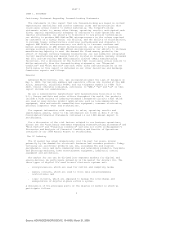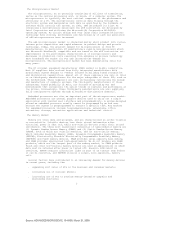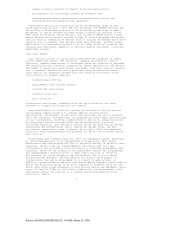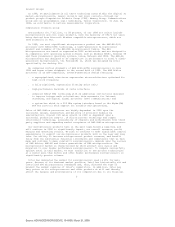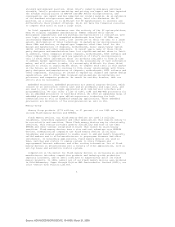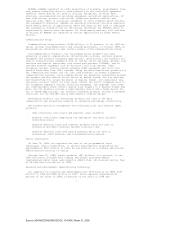AMD 1999 Annual Report Download - page 16
Download and view the complete annual report
Please find page 16 of the 1999 AMD annual report below. You can navigate through the pages in the report by either clicking on the pages listed below, or by using the keyword search tool below to find specific information within the annual report.notice, generally allow for the return of our products if the agreement with
the distributor is terminated. The market for our products is generally
characterized by, among other things, severe price competition. The price
protection and return rights we offer to our distributors could materially and
adversely affect us if there is an unexpected significant decline in the price
of our products.
Our international sales operations entail political and economic risks,
including expropriation, currency controls, exchange rate fluctuations,
changes in freight rates and changes in rates and exemptions for taxes and
tariffs.
Raw Materials
Certain raw materials we use in the manufacture of our products are
available from a limited number of suppliers. For example, a few foreign
companies principally supply several types of the IC packages purchased by us,
as well as by the majority of other companies in the semiconductor industry.
Interruption of supply, increased demand in the industry or currency
fluctuations could cause shortages in various essential materials. We would
have to reduce our manufacturing operations if we were unable to procure
certain of these materials. This reduction in our manufacturing operations
could have a material adverse effect on our business. To date, we have not
experienced significant difficulty in obtaining the raw materials required for
our manufacturing operations.
Environmental Regulations
We could possibly be subject to fines, suspension of production, alteration
of our manufacturing processes or cessation of our operations if we fail to
comply with present or future governmental regulations related to the use,
storage, handling, discharge or disposal of toxic, volatile or otherwise
hazardous chemicals used in our manufacturing processes. Such regulations
could require us to acquire expensive remediation equipment or to incur other
expenses to comply with environmental regulations. Our failure to control the
use, disposal or storage of, or adequately restrict the discharge of,
hazardous substances could subject us to future liabilities and could have a
material adverse effect on our business.
Intellectual Property and Licensing
We have been granted over 2,500 United States patents, and have several
thousand patent applications pending in the United States. In certain cases,
we have filed corresponding applications in foreign jurisdictions. We expect
to file future patent applications in both the United States and abroad on
significant inventions as we deem appropriate.
In January 1995, we reached an agreement with Intel to settle all previously
outstanding legal disputes between the two companies. As part of the
settlement, in December 1995, we signed a five-year, comprehensive cross-
license agreement with Intel which expires on December 31, 2000. The agreement
provides that after December 20, 1999, the parties will negotiate in good
faith a patent cross-license agreement to be effective on January 1, 2001. The
existing cross-license agreement gives AMD and Intel the right to use each
others' patents and certain copyrights, including copyrights to the x86
instruction sets but excluding other microprocessor microcode copyrights. The
cross-license is royalty-bearing for our products that use certain Intel
technologies. We are required to pay Intel minimum non-refundable royalties
during the years 1997 through 2000.
In addition, we have entered into numerous cross-licensing and technology
exchange agreements with other companies under which we both transfer and
receive technology and intellectual property rights. Although we attempt to
protect our intellectual property rights through patents, copyrights, trade
secrets and other measures, we cannot give any assurance that we will be able
to protect our technology or other intellectual property adequately or that
competitors will not be able to develop similar technology independently. We
cannot give any assurance that any patent applications that we may file will
be issued or that foreign intellectual property laws will protect our
intellectual property rights. We cannot give any assurance that any patent
licensed by or issued
12
Source: ADVANCED MICRO DEVIC, 10-K405, March 21, 2000


